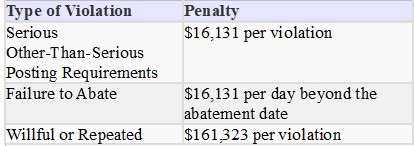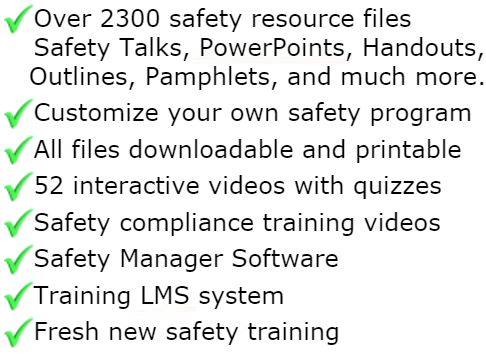
Lead Hazards Safety
Lead overexposure is one of the most common overexposures found in industry and is a leading cause of workplace illness. The reduction of lead exposure is a high strategic priority. OSHA five year strategic plan sets a performance goal of a 15% reduction in the average severity of lead exposure or employee blood lead levels in selected industries and workplaces.
Operations that generate lead dust and fume include the following:
• Flame-torch cutting, welding, the use of heat guns, sanding, scraping and grinding of lead painted surfaces in repair, reconstruction, dismantling, and demolition work;
• Abrasive blasting of bridges and other structures containing lead-based paints;
• Use of torches and heat guns, and sanding, scraping, and grinding lead-based paint surfaces during remodeling or abating lead-based paint; and
• Maintaining process equipment or exhaust duct work.
The most effective way to protect workers is to minimize exposure through the use of engineering controls and good work practices. It is OSHA policy that respirators are not to be used in lieu of engineering and work practices to reduce employee exposures to below the PEL. Respirators can only be used in combination with engineering controls and work practices to control employee exposures.
At the minimum, the following elements should be included in the employer's worker protection program for employees exposed to lead:
• Hazard determination, including exposure assessment
• Engineering and work practice controls
• Respiratory protection
• Protective clothing and equipment
• Housekeeping
• Hygiene facilities and practices
• Medical surveillance and provisions for medical removal
• Training• Signs & Symptoms
• Recordkeeping.
To implement the worker protection program properly, the employer needs to designate a competent person. The competent person must have the authorization to take prompt corrective measures to eliminate such problems. Qualified medical personnel must be available to advise the employer and employees on the health effects of employee lead exposure and supervise the medical surveillance program..
Lead Hazard Engineering Controls
Because lead is a cumulative and persistent toxic substance and because lead-caused health effects may result from low levels of exposure over prolonged periods of time, engineering controls and good work practices must be used where feasible to minimize employee exposure to lead. At a minimum, exposures must not exceed the OSHA interim final PEL of 50 micrograms per cubic meter of air (50 ug/m(3)) averaged over an 8-hour-period. When feasible engineering controls and work practice controls cannot reduce worker exposure to lead to at or below 50 ug/m(3), respirators must be used to supplement the use of engineering and work practice controls.
A competent person should review all site operations and stipulate the specific engineering controls and work practices designed to reduce worker exposure to lead. Engineering measures include local and general exhaust ventilation, process and equipment modification, material substitution, component replacement, and isolation or automation.
Exhaust Ventilation to Control Lead Dust
Power tools used for the removal of lead-based paint should be equipped with dust collection shrouds or other attachments exhausted through a high-efficiency particulate air (HEPA) vacuum system. Operations such as welding, cutting/burning, heating should be provided with local exhaust ventilation. HEPA vacuums should be used during clean-up activities.
For abrasive blasting operations where full containment exists or is required, the containment structure should be designed to optimize the flow of ventilation air past the workers, so that the airborne concentration of lead is reduced and the visibility is increased. The affected area should be maintained under negative pressure to reduce the chances that lead dust will contaminate areas outside the enclosure. A containment structure should be equipped with dust collection and an air-cleaning device to control emissions of particulate matter to the environment.
Lead Enclosure and Encapsulation
Lead-based paint can be made inaccessible either by encapsulating it with a material that bonds to the surface, such as acrylic or epoxy coating or flexible wall coverings, or by enclosing it using systems such as gypsum wallboard, plywood paneling, and aluminum, vinyl or wood exterior siding. Floors coated with lead-based paint can be covered using vinyl tile or linoleum flooring.
The building owner, or other responsible person, should oversee the custodial and maintenance staffs and contractors with regard to all activities that involve enclosed or encapsulated lead- based paint. This will minimize potential inadvertent release of lead during maintenance, renovation, or demolition.
Substitution with Non-Hazardous Materials
Zinc-containing primers covered by an epoxy intermediate coat and polyurethane topcoat are commonly used instead of lead-containing coatings.
Mobile hydraulic shears can be substituted for torch cutting under certain circumstances.
Surface preparation equipment, such as needle guns with multiple reciprocating needles completely enclosed within an adjustable shroud, can be substituted for abrasive blasting under certain operations. The shroud captures dust and debris at the cutting edge and can be equipped with a HEPA vacuum filtration system with a self-drumming feature. One such commercial unit can remove lead-based paint from flat steel and concrete surfaces, outside edges, inside corners, and pipes.
All materials in the members area for this topic index
Program Material | ||
Programs (written) | (1) | |
| Lead Safety General Industry Safety Program | Download | |
Fact Sheets | (2) | |
| Household Lead Safety | Download | |
| Lead Safety Topic Fact Sheet | Download | |
Training Material | ||
PowerPoints | (1) | |
| Lead Hazards PowerPoint | Download | |
Talks | (2) | |
| Chemical Lead Talk Spanish | Download | |
| Chemical Lead Talk | Download | |

GET INSTANT ACCESS
to THE MEMBERS LIBRARY
Safety materials created by safety professionals.
Access to the Safety Manager software.
Wide variety of safety videos and courses.
**Brand New** Safety Training Management System
Pre-Made Safety Materials Ready For Use
Created by experienced safety professionals & risk consultants. Saving you time, money, and risk of injuries.
95% of the work already done.
Below are the maximum penalty amounts, with the annual adjustment for inflation, that may be assessed after Jan. 15, 2024. (See OSHA Memo, Jan. 8, 2024).

**New OSHA HEAT 90 DAY**
>>Download Free HERE<<
**New 2024 OSHA 300 Form**
>>Download Free HERE<<
**Brand New**
Free with full membership subscription
Training LMS System
Ask The Safety Consultant
Safety Equipment Deal Finder

“SafetyInfo.com is the first go-to website for safety professionals and companies to use in establishing a solid safety program"
-Mike McKenzie, Certified Safety & Health Manager (CSHM), McSafety Solutions™
Note: You must have a full subscription to the Safety Library in order to use this material. Any use outside of your organization, for resell, or without an active membership is strictly prohibited and may result in prosecution under copyright infringement laws. Please contact us first, if you would be interested in reselling or using our materials for reproduction.
Inside the Members Library
Topic Index
Accident Prevention
Air Quality
Asbestos
Bloodborne Pathogens
Boilers
Chemical Safety
Compressed Gas
Confined Space
Construction
Construction Worksite
Cranes & Slings
Driver / Fleet Safety
Drug Free Workplace
Electrical
Emergency Management
Engineering Safety
Environmental
Equipment
Ergonomics
Fall Protection
Fire Safety & Prevention
First Aid
Flammable Materials
Forklifts
Hazard Communication
Hazardous Materials
Hearing Protection
Heat Stress
Hot Work
Housekeeping
Job Safety Analysis
Laboratory
Ladders
Lead
Lockout-Tagout
Machinery & Equipment
Material Handling
MSDS (SDS)
Medical & First Aid
Occupational Health
Office Safety
Off the Job Safety
Personal Protection
Process Safety
Record Keeping
Respiratory Protection
Silica Safety
Rules & Policies
Signs & Labels
Slips, Trips & Fall
Training
Terrorism Programs
Tool Safety
Vehicle & Driver
Violence Programs
Welding & Hot Work
Training Videos
Library Index
Training Materials
Videos/Courses
Talks
Articles
PowerPoint
Handouts
Training Overheads
Quizzes
Supervisor Briefs
Management Briefs
Safety Sessions
2 Minute OSHA Safety Talks
Pamphlets
First Aid Training
Supervisor Training
Hazardous Materials
Bomb Threat
Crossword Puzzles
Biological Agents
Forms & Documents
Forms
Checklists
Audit Guides
Inspections Guides
Signs & Labels
Environmental Audit Guides
Recordkeeping - OSHA 300
Sign & Label Maker
Safety Management Resources
Safety Manuals/Written Programs
Ergonomic Programs
Emergency Plans
Process Safety Management
Construction Safety
Occupational Health
Environmental
Topic Sheets
DOT Fleet-Driver
Hazardous Materials
Chemical Safety
Drug Free Workplace
Terrorism Programs
Development Guides
Safety Manager Software
Safety References & Graphics
Technical Safety Information
Posters
Topic & Fact Sheets
Development Information
Job Specific Safety Rules
Terrorism
Calculators
Safety Comic Strips
New Safety Training System
Schedule and train your employees with our materials. Add unlimited amount of employees. Record all progress and issue certificates. For group and individual training sessions.

